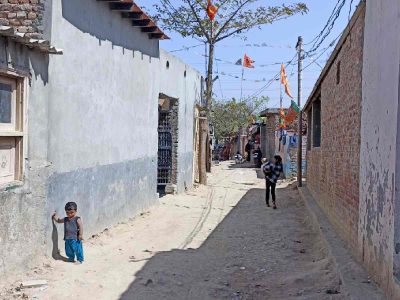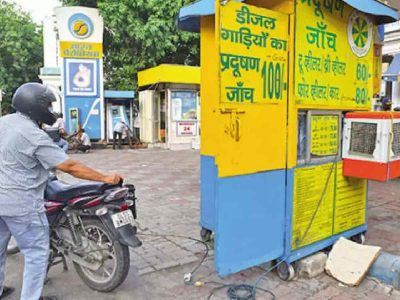Residents along the Yamuna River fear eviction after the National Green Tribunal (NGT) criticised the Delhi Development Authority (DDA) for failing to enforce its 2019 order to remove encroachments from the floodplain.
The NGT noted that despite more than five years passing, the directive remains unimplemented. It also emphasised that both the Delhi High Court and the Supreme Court have issued similar orders to protect the Yamuna.
Locals claim they have lived in the area since 1922, predating independence, and argue that no authority or court can remove them after more than 90 years of residence. With no alternative housing, they insist they have nowhere else to go.
They also assert that they have helped preserve the cultural heritage of the sacred river and are not responsible for its pollution, blaming large drains flowing into it instead.
‘We are not responsible for pollution’
Speaking to Patriot, Gopal Jha, a member of the Resident Welfare Association, Yamuna Bazar, shared the concerns of the community. “There are more than 1,100 families residing on the banks of the Yamuna. We have been living here since 1922. We have been permanent residents of this locality for generations. We have nowhere else to go,” he said.

Jha also refuted claims that the residents are responsible for polluting the river. “We are not the reason behind Yamuna’s pollution. Large drains flowing into the river, mainly the Najafgarh drain, are the real cause of contamination. Despite this, we are being targeted,” he asserted.
Another major challenge the residents face is the frequent flooding of the Yamuna, which causes significant damage to their homes. However, they refuse to leave. “Even during floods, we do not abandon our houses. We repair them and continue to live here. Every year, we suffer losses, but we endure because this is our home,” Jha explained.
‘Eviction will end Yamuna Aarti’
Another resident, Prakash Sharma, who was on his way to perform the Yamuna Aarti, emphasised the cultural significance of their presence. “Nobody in Delhi is more knowledgeable about performing this ritual. By evicting us, they will be shutting the doors of the Yamuna Aarti, which takes place at Vasudeva Ghat on the Yamuna Bank,” he said.
Sharma further explained their deep-rooted connection with the river. “We have been residing in this locality for decades. Three generations of our families have lived here. Now, the courts claim we are responsible for polluting the Yamuna, but we are the ones who help people perform last rites for their loved ones. The only things we place in the river are garlands and pind (wheat balls used in rituals), which do not pollute it,” he added.
NGT cites earlier directives
The tribunal also referenced its October 15, 2024 order, which sought details on the number of encroachments identified along the 22 km stretch of the Yamuna floodplain in Delhi, including those in Majnu Ka Tila—excluding encroachments by refugees from Pakistan.

“Even that direction has not been complied with in time,” the bench noted in its February 6, 2025 order.
Majnu Ka Tila residents challenge eviction
Majnu Ka Tila, often referred to as Delhi’s Little Tibet, is a vibrant cultural and commercial hub located on the banks of the Yamuna River. Established in 1962 as a settlement for Tibetan refugees, the area has since grown into a bustling neighbourhood known for its Tibetan monasteries, cafes, markets, and guesthouses. It serves as a major attraction for both tourists and Delhi residents, offering authentic Tibetan cuisine, handicrafts, and clothing. Beyond its commercial significance, Majnu Ka Tila remains a symbol of Tibetan heritage and resilience, with its residents deeply rooted in the locality for over six decades.
People residing in Majnu Ka Tila are furious over the recent decision of the NGT, as they claim they have been living in the locality since 1962.
Nudup Chophel, president of the Resident Welfare Association (RWA), Majnu Ka Tila, also spoke about the situation. “Our grandparents were from Tibet and came to the national capital in 1962. Since then, this has been our only home,” he said.
He emphasised the community’s peaceful nature and legal status. “We are peace-loving people, and our children are studying in the national capital. We pay taxes and have all the necessary identity proofs confirming that we are citizens of Delhi,” Chophel stated.
Regarding waste management, Chophel refuted allegations of pollution. “As far as waste disposal is concerned, Majnu Ka Tila has a proper sewage system built by the Delhi Jal Board (DJB) as per the guidelines. We do not dump any waste into the Yamuna directly,” he clarified.

Tenzing Rongmei, a refugee from the Northeast living in Majnu Ka Tila, expressed his deep concerns over the possible eviction, stating that more than 2,000 homes and families would be left in the lurch if authorities proceed with the removal.
“The authorities should give us an alternative piece of land where we can build our livelihood. If they want to remove us, they must ensure that thousands of families are not left homeless with no place to go,” Rongmei said.
Traders in Monastery Market fear loss of livelihood
Communities working at the Monastery Market are also reeling under mental stress following the NGT’s directions to the DDA.
Dhargyal, president of the Monastery Market Association, expressed concerns over the possible eviction, stating that it took nearly 40 years for the community to establish their livelihood.
“The entire national capital recognises Monastery Market for its quality and affordable clothing. Now, the authorities want to remove us and take away our means of survival,” he said.
He emphasised that traders have been lawful residents. “We have been here for the past 40 years. We vote, pay taxes, and fulfil all our duties as citizens. We don’t even dump garbage in the Yamuna. We are not responsible for its pollution,” Dhargyal said.
“If the authorities come to evict us, we will stage a fierce protest against them,” he added.
Also Read: 1984 anti-Sikh riots: The widows of Tilak Nagar
Tshering Wanggilama, who has lived in the locality for 45 years, accused officials of using beautification projects as a cover for corruption.
“The authorities want to bulldoze our houses and construct a park just so they can engage in multi-crore corruption,” Wanggilama claimed.
“Last year, the DDA demolished several homes along the Yamuna, yet they didn’t offer any alternative housing to those evicted,” he said.
He alleged that officials are prioritising commercial interests over people’s livelihoods. “We have been here for decades, paying taxes and fulfilling our duties as citizens. Now, they want to take our homes to create a meaningless park in the name of development,” he said.
Residents argue that their presence does not harm the environment and that they are being unfairly blamed for Yamuna River pollution, while large drains remain unchecked.
“We don’t dump waste in the river. The real cause of pollution is untreated sewage from major drains,” Wanggilama added.

The Monastery Market, known for its affordable clothing and cultural significance, has been a key shopping hub in Delhi for over 40 years. Traders and families fear that their displacement will not only destroy their livelihoods but also erase a thriving community.
Encroachment data and previous actions
An August 2024 Delhi government report revealed that 7,362.6 hectares of the 9,700 hectares in Zone O, which includes the Yamuna floodplain, were encroached upon. In an anti-encroachment drive between August 2022 and January 2024, the DDA reclaimed 300 acres by removing six dairies and three cricket grounds from the floodplain. The operation also covered biodiversity parks, eco-tourism areas, and other green zones, aiming to restore the area’s ecological balance.





